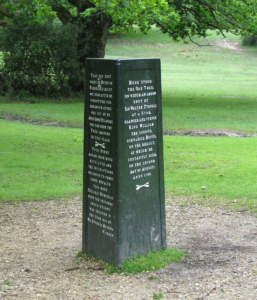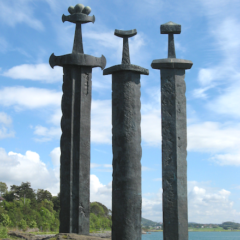At our latitudes the Vikings are not exactly the topic that is constantly on everyone’s mind (a bit more perhaps in Britain!) Nonetheless, there remain many traces and reminders from their everyday life and language. For example:
- Bluetooth: The standardised short-distance wireless communication which we love to use to connect our mobile phone to the (car-) loudspeaker or headphones, is named after King Harald I Gormsson called „Bluetooth“ (Danish: Harald Blåtand) *about 910, died Jan. 987. He was king of Denmark and parts of Norway. His memorial is preserved in the church and in the cemetery at Jellinge /DK and in the nearby famous Museum
.

His nickname „Bluetooth“ has nothing to do with a blue tooth as sometimes assumed.
The Bluetooth Special Interest Group (SIG), a consortium of several large electronic companies, gave the standardized radio link this name. - In the east and in the north of England (Norfolk, Cambridgeshire, Lincolnshire, Yorkshire etc.), i. e. in the old areas of the „Danelaw“, there are altogether more than eight hundred villages with Old Norse name endings, such as -by (=village) -thorpe (=hamlet) –thwaite (=grubbing-up) and -toft =place). Derby, Grimsby, Thornaby, Wetherby, Whitby, Althorpe, Millthorpe, Lowestoft, Sandtoft, Thwait, Thornswaite are some examples.
- The use of the final syllable -son for „son of…“ exists to this day (Johnson = son of John). But still mainly used in the old sense in Scandinavia and Iceland. Less well known but still used in Island, is the ending -dottir for „daughter of…“.
- Viking ships always had their distinctive rudder on the right-hand side, which is why the right-hand side of ships are still called the starboard side.
- Have you ever driven through the New Forest in the southwest of England (Hampshire, west of Southampton)? In this nature reserve, you can see wild horses and cattle which have absolute priority on the few roads. The New Forest was created by William the Conqueror to be his personal, royal hunting ground. He had the inhabitants of some farming villages driven out and would have them severely punished if caught poaching (for hunting a „royal deer“ = the hands would be chopped off!). The area is still sparsely populated and 90 % of the area is still owned by the English Crown. The New Forest was also a very inauspicious place for the family of William the Conqueror. Two of his sons died there in quite dubious circumstances. His successor William II “Rufus” died on 2.8.1100 in a spectacular and mysterious “hunting accident” (Probably an unsolved criminal case!?).

Rufus‘ Stone, near Lyndhurst/Hamps (Photo: Urs Pape)
- There are still many linguistic traces of the Old Viking Norse such as Wednesday (from God Wotan), Friday (Freya), knife (from knifr), egg (egg) or even Reykjavik (=the smoky bay).
- The Channel Islands are another reminder of the Vikings. The Channel Islands (les Illes Normandes) are a remnant of the empire of the „Kings of England and Normandy”. While the mainland parts of the historical duchy of Normandy have long belonged to France (since 13th Century), the Channel Islands are still Crown Dependencies to the English King/Queen since 1066 (as successors of the Norman kings) and continue to this day. This means that the two areas „Bailiwick of Jersey“ and „Bailiwick of Guernsey“; each with their surrounding islets, are directly subordinated to the English crown. They do not belong to the UK or the EU but are members of the EU customs community. They each have their own parliament, their own administration and their own tax systems, still being exploited to the full today, especially by Jersey. The consequences, still visible to tourists today, are interesting. While English is the official language and widely spoken, many place names are French. For the tourist, it is obvious, menus are written in French and, above all, the cuisine, is strongly inspired by the French, (and very pleasing too!). On the islands, old Norman French was spoken for a very long time (until the beginning of the 18th century) and is again today being fostered. Likewise, during the period of the Calvinistic Reformation and the separation of the Anglican Church, the islands remained largely Roman Catholic and subordinate to bishops of mainland France.
